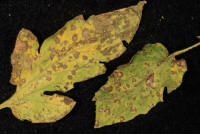Cost for the tr aining will be $100 per person for those
volunteering time through the Logan County group, with
supplemental funding of approximately $50 per person being
sponsored by the Logan County Master Gardeners. Noncompliance
with the volunteer service requirement will result in a bill to
recoup the actual cost of the training. The cost to those from
other Master Gardener programs will be $150. aining will be $100 per person for those
volunteering time through the Logan County group, with
supplemental funding of approximately $50 per person being
sponsored by the Logan County Master Gardeners. Noncompliance
with the volunteer service requirement will result in a bill to
recoup the actual cost of the training. The cost to those from
other Master Gardener programs will be $150.
Participants completing all 10 sessions will then be
considered interns, with the expectation of 60 hours of
volunteer service be completed within program guidelines within
the next two years. After the internship, the expectation is 30
hours of volunteer service and 10 hours of in-service education
minimums.

If you are interested in joining, the person to contact is
Don Miller in the Logan County Extension office, who will serve
as the coordinator. His contact information is
dgmille@illinois.edu
or 217-732-8289.

Anthracnose and apple scab
As predicted earlier in the season, fungi have really kicked
in on shade trees and ornamentals. Anthracnose is easily seen on
good-quality maples, and apple scab is rapidly defoliating both
crab apples and production apples that are not in a regular
spray program.
Both diseases fall into the category of "preventable but not
curable," but don't despair. Assuming the trees have enough
stored energy, they will leaf out next year and begin all over.
The disease may hit or not, depending on the weather conditions,
but odds are at some point in the year you will see it again on
susceptible varieties.
Tomatoes
Septoria leaf blight is attacking tomatoes again with a
vengeance. For a review, septoria leaf spot can also affect
plants at any stage of development. Numerous small, water-soaked
spots first appear on the lower leaves. These spots soon become
circular to angular with dark margins and grayish centers often
bearing one or more tiny black bodies called pycnidia, which are
spore-bearing structures. Individual lesions are seldom more
than one-eighth inch in diameter and are usually quite numerous
on an infected leaf. Heavily diseased leaves turn yellow, wither
and drop off in large numbers, starting at the base of the
plant. Defoliation can be severe during prolonged periods of
warm, wet weather.
[to top of second column] |

As for what to do, here is the checklist: First, keep ripe fruits picked off the
plants. Second, don't work around tomatoes when they are wet. Next, you can try
to improve air circulation, but if your tomatoes are severely affected, you
won't want to lose any more leaves. And the final step for this year is to try a
fungicide. Mancozeb is probably the recommended one, but it is very hard to
find. The other options are Daconil and maneb, which are easier to find but
probably won't give you as good a control. The final step for future years is to
practice at least a three-year rotation, with good sanitation in the garden.
Foundation sprays
The crickets, millipedes, earwigs, spiders, ants and many others
that find their way inside are a real nuisance. A foundation spray
is the best line of defense, and you would select a material such as
permethrin or bifenthrin to begin with. Then spray the foundation
and the adjacent foot or two of soil or plant material with the
mixture. Both these products are cleared on most types of plants.
Foundation treatments should be applied every seven to 15 days
depending on the temperatures. The materials break down quicker in
hot weather.
Foundation treatments won't prevent all bugs from getting into
the house and certainly won't kill those already in the house. For
insects already in the house, you have a few options. The first is
mechanical control. This is fancy language for something like a fly
swatter, shoe, vacuum cleaner, flypaper or glue boards. The next is
chemical control. This basically means aerosol cans inside the
house. The most common sprays are for flying insects or ants,
although many of the flying insect killers now have permethrin in
them and can last quite a while.
[By
JOHN FULTON,
University of Illinois Extension, Logan County]

 |